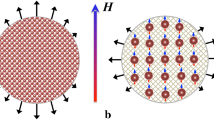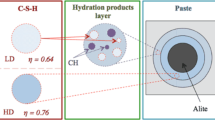Abstract
A method for identifying normal and anomalous thixotropy hysteresis in elastomeric composites containing powdered reinforcement materials of different nature is proposed, and the explanation of existence of the two forms of hysteresis is provided. We assume that large superstructural elements—clusters consisting of a number of reinforcement particles, of colloidal particles, and of the matrix—may arise in such systems. The formation of clusters in the system gives rise to normal hysteresis, and hysteresis is anomalous in the absence of clusters. Instant thixotropy is observed when the rates of formation and disintegration of clusters are equal. The hysteresis changes its character in the inversion regions, which are the regions of critical shear stress that divides the stress–shear velocity field into low- and high-velocity domains.
Similar content being viewed by others
References
Baurova, N.I. and Zorin, V.A., Primenenie polimernykh kompozitsionnykh materialov pri proizvodstve i remonte mashin. Uchebnoe posobie (Manual on Application of Polymeric Composites in Manufacturing and Reparation of Machines), Moscow: Mosk. Avtomob.-Dorozhn. Inst., 2016.
Baurova, N.I., Zorin, V.A., and Prikhod’ko, V.M., Description of the degradation of material properties using the catastrophe theory, Vse Mater., 2014, no. 11, pp. 14–19.
Tatarnikov, O.V., Three-level design of spatially reinforced composite constructions, Vse Mater., 2012, no. 7, pp. 21–26.
Tatarnikov, O.V., Malysheva, G.V., Akhmetova, E.Sh., and Morozov, B.B., Finite-element modeling of the heat mode of autoclave hardening of a three-layer panel, Polym. Sci., Ser. D, 2016, vol. 9, no. 1, pp. 13–16.
Nelyub, V.A., Borodulin, A.S., Kobets L.P., and Malysheva, G.V., Capillary hydrodynamics of oligomer binder, Polym. Sci., Ser. D, 2016, vol. 9, no. 3, pp. 322–325.
Nelyub, V.A., Determination of adhesion interaction between carbon fiber and epoxy binder, Polym. Sci., Ser. D, 2015, vol. 8, no. 1, pp. 6–8.
Nelyub, V.A., Borodulin, A.S., Kobets, L.P., and Malysheva, G.V., Viscous hysteresis in filled siloxane binders, Polym. Sci., Ser. D, 2017, vol. 10, no. 1, pp. 19–22.
Kobets, L.P. and Borodulin, A.S., Rheological properties of polymer binder-discrete metal filler system, Entsikl. Inzh.-Khim., 2015, no. 6, pp. 9–14.
Kobets, L.P., Malysheva, G.V., and Borodulin, A.S., Rheological properties of system “elastomer binder–discrete carbon fiber,” Inorg. Mater.: Appl. Res., 2016, vol. 7, no. 1, pp. 15–19.
Author information
Authors and Affiliations
Corresponding author
Additional information
Original Russian Text © V.A. Nelyub, A.S. Borodulin, L.P. Kobets, G.V. Malysheva, 2017, published in Materialovedenie, 2017, No. 11, pp. 3–8.
Rights and permissions
About this article
Cite this article
Nelyub, V.A., Borodulin, A.S., Kobets, L.P. et al. Thixotropy Hysteresis and Structure Formation in Elastomeric Suspensions. Inorg. Mater. Appl. Res. 9, 603–608 (2018). https://doi.org/10.1134/S2075113318040238
Received:
Published:
Issue Date:
DOI: https://doi.org/10.1134/S2075113318040238




